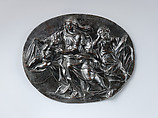The rest on the flight into Egypt
Alessandro Algardi Italian
Not on view
This composition is one of Alessandro Algardi’s most reproduced designs, versions of which were carved or cast in various materials and widely collected.[1] Although no early sources or documents confirm his authorship, scholarly consensus has settled on Algardi based on stylistic comparisons and the existence of a late seventeenth-century French engraving that presents the composition in reverse with an inscription recording his name.[2] Citing “the gentle flow of the modelling across the plane with no deep contrasts of volume, and the nonchalant treatment of spatial relationships,” Jennifer Montagu dates the design to the second half of the 1630s.[3]
The finest examples of the relief include octagonal bronzes in the Fitzwilliam and at Yale; and oval bronzes in the Museo Nazionale del Palazzo di Venezia and the Palazzo Pallavicini-Rospigliosi, both in Rome. The Fitzwilliam and Palazzo Venezia plaques are gilt.[4] All four include details missing in The Met relief: an angel holding up a curtain attached to a tree and the background landscape. Our reduced variant was also widely produced and exists in multiple versions. With the figures floating against a neutral background, the abstracted design presents the scene extratextually—unbound from narrative concerns—and delivers a timeless, elevated vision. The viscous, flowing drapery in our relief places its production at a remove from Algardi’s Roman workshop; as per Montagu, it is “rather too smooth and slick.”[5] The bronze has a dark brown opaque patina that conceals the insertion of the Virgin’s head, separately cast and soldered on.[6] There are two small soldered bronze patches, one on the Virgin’s lap and one between Saint Joseph’s legs, both original.
The composition may be related to several drawings by Algardi, including The Rest on the Flight into Egypt in the Royal Collection, Windsor, and The Met’s Holy Family.[7] None of the drawings exactly corresponds to the reliefs, but they do show an artist experimenting. Relief sculpture was sometimes displayed in seventeenth-century Roman palaces alongside framed drawings, inviting viewers to make comparisons between mediums.[8] Such juxtapositions suggest a role for Algardi’s Holy Family drawings that was not merely functional.
The relief entered The Met in 1938 along with another depicting Jesuit saints and martyrs (cat. 147) as part of a purchase from the New York–based Kingsley Falkenberg, whose father Herman, a member of the American Numismatic Society, had amassed a considerable collection of Renaissance and Baroque plaques. Twenty-two of these came to the museum.
-JF
Footnotes
(For key to shortened references see bibliography in Allen, Italian Renaissance and Baroque Bronzes in The Metropolitan Museum of Art. NY: The Metropolitan Museum of Art, 2022.)
1. For the various versions, see Montagu 1985, vol. 2, pp. 307–9.
2. See Pietro Cannata’s summary in Montagu 1999a, pp. 122–23, cat. 13. The engraving, by Edward Le Davis, was produced in Paris. The inscription reads “Alexander Algardi inu—franc. Chauveau excudit C.P.R—Edwardus le Davis fecit.” See Montagu 1985, vol. 2, p. 309, no. 4.E.1. 3. Montagu 1985, vol. 2, p. 307.
4. Fitzwilliam and Pallavicini reliefs: ibid., pp. 307–8, nos. 4.C.2, 4.C.10; Palazzo di Venezia relief: Cannata in Montagu 1999a, pp. 122–23, cat. 13; Yale relief: Montagu in Heller 2002, p. 104, cat. 36.
5. Montagu 1985, vol. 2, p. 308, no. 4.C.8.
6. R. Stone/TR, January 27, 2011.
7. RCIN, 902348; MMA, 1997.374.
8. See Desmas and Freddolini 2014, p. 267.
Due to rights restrictions, this image cannot be enlarged, viewed at full screen, or downloaded.


